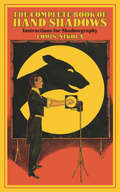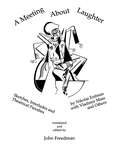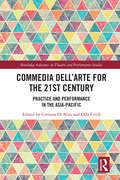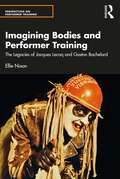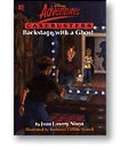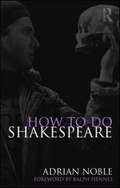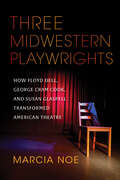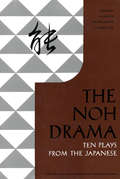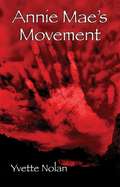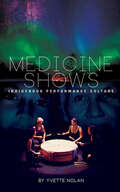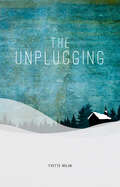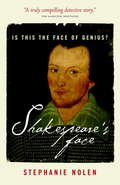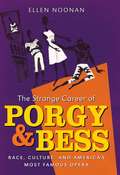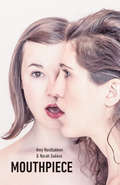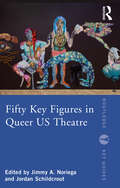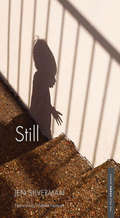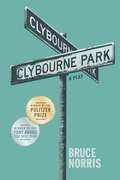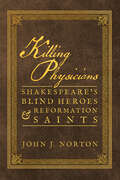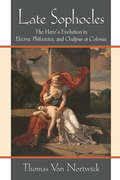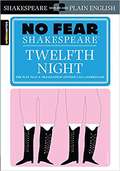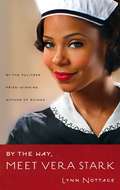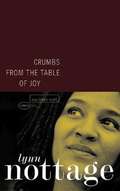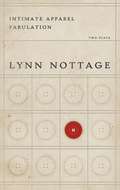- Table View
- List View
The Complete Book of Hand Shadows: Instructions for Shadowgraphy
by Louis NikolaGenerations of entertainers have amused audiences of children and adults with the art of hand shadows, using only a light source and their own two hands to form immediately recognizable profiles of people and animals. Lovers of nostalgia and aspiring hand shadow artists will delight in this facsimile of a 1913 book, which features more than 50 hand shadows. These quaint illustrations depict many different types of shadows, from swans, rabbits, and other animals to historic figures and fictional characters. Each hand shadow is accompanied by a description of specific hand positioning and an illustration. Additional helpful tips include instructions on lighting, projection screens, and hand exercises.
A Meeting About Laughter
by Nikolai Erdman; Vladimir Mass; John FreedmanFirst Published in 1995. A Meeting About Laughter is a collection of sketches, interludes and theatrical parodies by Nikolai Erdman, Vladimir Mass and others. Translated from the Russian Theatre Archive by John Freedman, Harvard University. Erdman is best known as the author of The Warrant and The Suicide, both written for Vsevolod Meyerhold in the 1920s. Also including the transcript of a startling discussion of The Suicide at the Vakhtangov Theatre in 1930 and the only surviving fragments of Erdman's third play The Hypnotist.
Commedia dell’Arte for the 21st Century: Practice and Performance in the Asia-Pacific (Routledge Advances in Theatre & Performance Studies)
by Corinna Di Niro Olly CrickThis book discusses the evolution of Commedia dell’Arte in the Asia-Pacific where through the process of reinvention and recreation it has emerged as a variety of hybrids and praxes, all in some ways faithful to the recreated European genre. The contributors in this collection chart their own training in the field and document their strategies for engaging with this form of theatre. In doing so, this book examines the current thoughts, ideas, and perceptions of Commedia – a long-standing theatre genre, originating in a European-based collision between neo-classical drama and oral tradition. The contributing artists, directors, teachers, scholars and theatre-makers give insight into working styles, performance ideas, craft techniques and ways to engage an audience for whom Commedia is not part of their day-to-day culture. The volume presents case studies by current practitioners, some who have trained under known Commedia ‘masters’ (e.g. Lecoq, Boso, Mazzone-Clementi and Fava) and have returned to their country of origin where they have developed their performance and teaching praxis, and others (e.g. travelling from Europe to Japan, Thailand, Singapore and China) who have discovered access points to share or teach Commedia in places where it was previously not known. This book will be of great interest to students and scholars in Performing arts, Italian studies, and History as well as practitioners in Commedia dell’Arte.
Imagining Bodies and Performer Training: The Legacies of Jacques Lecoq and Gaston Bachelard (Perspectives on Performer Training)
by Ellie NixonThis book is a practical and theoretical exploration of the embodied imagining processes of devised performance in which the human and more-than-human are co-implicated in the creative process.This study brings together the work of French theatre pedagogue Jacques Lecoq (1921–1999) and French philosopher of science and the imagination Gaston Bachelard (1884–1962) to explore the notion of the imagination as embodied, enactive and embedded in the devising process. An exploration of compelling correspondences with Bachelard, whose writings imbue Lecoq’s teaching ethos, offers new practical and theoretical perspectives on Lecoq’s ‘poetic body’ in contemporary devising practices. Interweaving first-hand accounts by the author and interviews with contemporary international creative practitioners who have graduated from or have been deeply influenced by Lecoq, Imagining Bodies in Performer Training interrogates how his teachings have been adapted, developed and extended in various cultural, political and historical settings, in Europe, Scandinavia, Asia, and North and South America.These new and rich insights reveal a teaching approach that resists fixity and instead unfolds, develops and adapts to the diverse cultural and political contexts of its practitioners, teachers and students.
And Maggie Makes Three
by Joan Lowery NixonMaggie, living with her grandmother in Houston, joins the drama club at school, wins a part in a play, begins to make friends, and learns to deal with feelings of loneliness, being in love, and having an unusual family life and background.
Backstage with a Ghost
by Joan Lowery NixonBrian and Sean investigate a series of suspicious accidents at a theater waiting to be torn down.
How to do Shakespeare
by Adrian NobleThe author has worked on Shakespeare with everyone from Oscar-nominated actors to groups of schoolchildren. Here he draws on several decades of top-level directing experience to shed new light on how to bring some of theatre’s seminal texts to life. <p><p> He shows you how to approach the perennial issues of performing Shakespeare, including: wordplay – using colour and playing plain, wit and comedy, making language muscular; building a character – different strategies, using the text, Stanislavski and Shakespeare; shape and structure – headlining a speech, playing soliloquys, determining a speech’s purpose and letting the verse empower you; dialogue – building tension, sharing responsibility and ’passing the ball’. <p><p> This guided tour of Shakespeare’s complex but unfailingly rewarding work stunningly combines instruction and inspiration.
Three Midwestern Playwrights: How Floyd Dell, George Cram Cook, and Susan Glaspell Transformed American Theatre
by Marcia NoeIn the early 1900s, three small-town midwestern playwrights helped shepherd American theatre into the modern era. Together, they created the renowned Provincetown Players collective, which not only launched many careers but also had the power to affect US social, cultural, and political beliefs.The philosophical and political orientations of Floyd Dell, George Cram Cook, and Susan Glaspell generated a theatre practice marked by experimentalism, collaboration, leftist cultural critique, rebellion, liberation, and community engagement. In Three Midwestern Playwrights, Marcia Noe situates the origin of the Provincetown aesthetic in Davenport, Iowa, a Mississippi River town. All three playwrights recognized that radical politics sometimes begat radical chic, and several of their plays satirize the faddish elements of the progressive political, social, and cultural movements they were active in.Three Midwestern Playwrights brings the players to life and deftly illustrates how Dell, Cook, and Glaspell joined early 20th-century midwestern radicalism with East Coast avant-garde drama, resulting in a fresh and energetic contribution to American theatre.
The Noh Drama: Ten Plays from the Japanese (Unesco collection of representative works)
by Noh CommitteeThis classic of Japanese studies presents extensive information about the history, culture and practice of Noh drama--one of Japan's most treasured dramatic art forms.<P><P>Noh as an independent and original art form--ultimately destined to supersede the earlier Dengaku, Sarugaku and other song dances--incorporates the most significant elements of the former and especially of the Kusemai (tune dance).With it a new literary form may be said to have been created.The invention of Noh is attributed to Kwannami Kiyotsugu (1333-1384), a distinguished actor and writer of Sarugaku and to his son Zeami Motokiyo (1363-1443), who developed and refined the art under the patronage of Yoshimitsu, the third Ashikaga shogun. In addition to his dramatic activities, Zeami composed a number of works, the most important of which is called the Kwadensho (the Book of the Flower), or more properly, Fushi-kwadensho which he explained the nature and aesthetic principles governing Noh plays, and gave detailed instructions concerning the manner of composition, acting, direction, and production of these dramas.Combining the elements of dance, miming, music, and chants, Noh plays may be described as lyrico-dramatic tone-poems, in which the text has a function somewhat similar to that of the libretto in a Wagner or Debussy opera.
Annie Mae's Movement
by Yvette NolanAnnie Mae’s Movement explores what it must have been like to be Anna Mae Pictou Aquash, a woman in a man’s movement, a Canadian in America, an Aboriginal in a white-dominant culture at a time when it felt like we could really change the world. Dying under mysterious circumstances, it is still unclear what really happened to Anna Mae back in the late 70s. Instead of recounting cold facts, this play looks for the truth in examining the life and death of this remarkable Aboriginal woman; that we cannot know the consequences of our actions; that we live on in the work that we do and the people we affect long after we have passed from this world.
Medicine Shows: Indigenous Performance Culture
by Yvette NolanContemporary Indigenous theatre in Canada is only thirty-three years old, if one begins counting from the premiere of Maria Campbell’s Jessica in Saskatoon and the establishment of Native Earth Performing Arts in Toronto. Since those contemporaneous events in 1982, the Canadian community of Indigenous theatre artists has grown and inspired one another.Medicine Shows: Indigenous Performance Culture traces the work of a host of these artists over the past three decades, illuminating the connections, the artistic genealogy, and the development of a contemporary Indigenous theatre practice. Neither a history nor a chronicle,Medicine Shows examines how theatre has been used to make medicine, reconnecting individuals and communities, giving voice to the silenced and disappeared, staging ceremony, and honouring the ancestors.
The Unplugging
by Yvette NolanForced to rely upon traditional wisdom for their survival, Elena and Bern retreat from the remains of civilization to a freezing, desolate landscape where they attempt to continue their lives after the end of the world. When a charismatic stranger from the village arrives seeking their aid, the women must decide whether they will use their knowledge of the past to give the society that rejected them the chance at a future.
Shakespeare's Face
by Stephanie NolenOn May 11, 2001, Globe and Mail reporter Stephanie Nolen announced a stunning discovery to the world: an attractive portrait held by an Ontario family for twelve generations, which may well be the only known portrait of Shakespeare painted during his lifetime. Shakespeare's Face is the biography of a portrait -- a literary mystery story -- and the furious debate that has ensued since its discovery.A slip of paper affixed to the back proclaims "Shakespere. This likeness taken 1603, Age at that time 39 ys." But is it really Shakespeare who peers at us from the small oil on wood painting? The twinkling eyes, reddish hair, and green jacket are not in keeping with the duller, traditional images of the bard. But they are more suggestive of the humorous and humane man who wrote the greatest plays in the English language.Shakespeare's Face tells the riveting story of how the painting came to reside in the home of a retired engineer in a mid-sized Ontario town. The painting is reputed to be by John Sanders of Worcester, England. As a retirement project, the engineer, whose grandmother kept the family treasure under her bed, embarked on authenticating the portrait: the forensic analyses that followed have proven it without doubt to the period.In a remarkable publishing coup, Knopf Canada has gathered around Stephanie Nolen's story a group of the world's leading Shakespeare scholars and art and cultural historians to delve into one of the most fascinating literary mysteries of our times: "Is this the face of genius?"Excerpt from Chapter 1 of Shakespeare's Face by Stephanie NolenBy the late afternoon I was beginning to go a little cross-eyed. I had examined countless documents and read the test results from the painting's painstaking forensic analysis. I now had everything I needed to write my story -- except for one crucial item. "Is he here?" I asked, almost in a whisper....The owner laid the package carefully on the cluttered table. He gently pulled back the kraft paper wrapping, underneath which was a layer of bubble wrap. Then he peeled back this second layer to reveal his treasure.I was caught off-guard by how small the portrait was -- and how vivid. The colours in the paint seemed too rich to be 400 years old. Except for the hairline cracks in the varnish, the face could have been painted yesterday. And there was nothing austere or haughty about it, nothing of the great man being painted for posterity. It was a rogue's face, a charmer's face that looked back at me with a tolerant, mischievous slightly world-weary air....It was painted on two pieces of solid board so expertly joined that the seam was barely visible. A date, "Ano 1603", was painted in small red letters in the top right hand corner. The right side had been nibbled by woodworms.... I stood and gazed, quelling an instinctive urge to pick the portrait up and hold it in my hands. And as my professional skepticism crumpled for a moment, I found myself wanting desperately to believe that this was indeed Shakespeare's face.
The Strange Career of Porgy and Bess
by Ellen NoonanCreated by George Gershwin and DuBose Heyward and sung by generations of black performers, Porgy and Bess has been both embraced and reviled since its debut in 1935. In this comprehensive account, Ellen Noonan examines the opera's long history of invention and reinvention as a barometer of twentieth-century American expectations about race, culture, and the struggle for equality. In its surprising endurance lies a myriad of local, national, and international stories.For black performers and commentators, Porgy and Bess was a nexus for debates about cultural representation and racial uplift. White producers, critics, and even audiences spun revealing racial narratives around the show, initially in an attempt to demonstrate its authenticity and later to keep it from becoming discredited or irrelevant. Expertly weaving together the wide-ranging debates over the original novel, Porgy, and its adaptations on stage and film with a history of its intimate ties to Charleston, The Strange Career of "Porgy and Bess" uncovers the complexities behind one of our nation's most long-lived cultural touchstones.
When Heroes Sing
by Sarah NooterThis book examines the lyrical voice of Sophocles' heroes and argues that their identities are grounded in poetic identity and power. It begins by looking at how voice can be distinguished in Greek tragedy and by exploring ways that the language of tragedy was influenced by other kinds of poetry in late fifth-century Athens. In subsequent chapters, Professor Nooter undertakes close readings of Sophocles' plays to show how the voice of each hero is inflected by song and other markers of lyric poetry. She then argues that the heroes' lyrical voices set them apart from their communities and lend them the authority and abilities of poets. Close analysis of the Greek texts is supplemented by translations and discussions of poetic features more generally, such as apostrophe and address. This study offers new insight into the ways that Sophoclean tragedy inherits and refracts the traditions of other poetic genres.
Mouthpiece
by Norah Sadava Norah Sadava Amy NostbakkenWinner of the 2017 Toronto Theatre Critics Award for Best New Canadian PlayWinner of three Dora Mavor Moore AwardsStage Award for Best Performance, 2017 Edinburgh Festival FringeMouthpiece follows one woman, for one day, as she tries to find her voice. Two performers express the inner conflict that exists within a modern woman's head: the push and pull, the past and the present, the progress and the regression. Interweaving a cappella harmony, dissonance, text, and physicality, Mouthpiece is a harrowing, humorous, and heart-wrenching journey into the female psyche.
Fifty Key Figures in Queer US Theatre (Routledge Key Guides)
by Jimmy A. Noriega Jordan SchildcroutWhether creating Broadway musicals, experimental dramas, or outrageous comedies, the performers, directors, playwrights, designers, and producers profiled in this collection have contributed to the representation of LGBTQ lives and culture in a variety of theatrical venues, both within the queer community and across the US theatrical landscape. Moving from the era of the Stonewall Riots to today, notable scholars in the field bring a wide variety of queer theatre artists into conversation with each other, exploring connections and differences in race, gender, physical ability, national origin, class, generation, aesthetic modes, and political goals, creating a diverse and inclusive study of 50 years of queer theatre. For readers seeking an introduction to or a deeper understanding of LGBTQ theatre, this volume offers thought-provoking analyses of theatre-makers both celebrated and lesser-known, mainstream and subversive, canonical and new.
Still
by Marsha Norman Jen SilvermanIn this darkly comic exploration of loss, intimacy, and motherhood, three women are joined by a baby who never lived. Morgan, in her middle years, is the grieving mother of a stillborn child. Elena, the failed midwife, burdened by guilt, is considering a career change. Dolores, eighteen, is pregnant with a baby she does not want. Meanwhile, Constantinople, the child who wasn't meant to be, wanders lost in search of his mother, trying to make sense of the world while making an unlikely appearance in each woman's personal drama. Poignant, lyrical, ingeniously absurd, and outrageously funny, Jen Silverman's Still is a brave and remarkable exploration of grief and family. It is the seventh winner of the DC Horn Foundation/Yale Drama Series Prize, selected this year by Marsha Norman, the Pulitzer Prize-winning author of Getting Out; 'night, Mother; and other acclaimed theatrical works.
Clybourne Park: A Play
by Bruce NorrisClybourne Park spans two generations fifty years apart. In 1959, Russ and Bev are selling their desirable two-bedroom at a bargain price, unknowingly bringing the first black family into the neighborhood (borrowing a plot line from Lorraine Hansberry's A Raisin in the Sun) and creating ripples of discontent among the cozy white residents of Clybourne Park. In 2009, the same property is being bought by a young white couple, whose plan to raze the house and start again is met with equal disapproval by the black residents of the soon-to-be-gentrified area. Are the issues festering beneath the floorboards actually the same, fifty years on? Bruce Norris's excruciatingly funny and squirm-inducing satire explores the fault line between race and property. Clybourne Park is the winner of the 2011 Pulitzer Prize for Drama, and the winner of the 2012 Tony Award for Best Play.
Killing Physicians: Shakespeare's Blind Heroes and Reformation Saints
by John J NortonKilling Physicians: Shakespeare's Blind Heroes and Reformation Saints is intended give its reader a street-level perspective of Shakespeare's great tragedies and late plays.Diving into the social and theological tensions alive in sixteenth-century London neighborhoods, this book uncovers what may have been Shakespeare's answer to a world fraught with political and religious controversy.
Late Sophocles: The Hero’s Evolution in Electra, Philoctetes, and Oedipus at Colonus
by Thomas Van NortwickOnly a few plays by Sophocles--one of the great tragic playwrights from Classical Athens--have survived, and each of them dramatizes events from the rich store of myths that framed literature and art. Sophocles' treatment evokes issues that were vividly contemporary for Athenian audiences of the Periclean age: How could the Athenians incorporate older, aristocratic ideas about human excellence into their new democratic society? Could citizens learn to be morally excellent, or were these qualities only inherited? What did it mean to be a creature who knows that he or she must die? Late Sophocles traces the evolution of the Sophoclean hero through the final three plays, Electra, Philoctetes, and Oedipus at Colonus. The book's main thesis, that Sophocles reimagined the nature of the tragic hero in his last three works, is developed inductively through readings of the plays. This balanced approach, in which a detailed argument about the plays is offered in a format accessible to nonspecialists, is unusual--perhaps unique--in contemporary Classical scholarship on Sophocles. This book will appeal to nonspecialist readers of serious literature as well as scholars of classical and other literatures. While including ample guidance for those not familiar with the plays, Late Sophocles goes beyond a generalized description of "what happens" in the plays to offer a clear, jargon-free argument for the enduring importance of Sophocles' plays. The argument's implications for longstanding interpretational issues will be of interest to specialists. All Greek is translated.
Twelfth Night (No Fear Shakespeare #8)
by Spark NotesDon’t be intimidated by Shakespeare! These popular guides make the Bard’s plays accessible and enjoyable. <P><P> Each No Fear guide contains: The complete text of the original play A line-by-line translation that puts the words into everyday language A complete list of characters, with descriptions Plenty of helpful commentary
By the Way, Meet Vera Stark
by Lynn Nottage"Nottage is one of our finest playwrights, a smart, empathetic, and daring storyteller who tells a story an audience won't expect." Time Out New York"Lynn Nottage's work explores depths of humanness, the overlapping complexities of race, gender, culture and history and the startling simplicity of desire with a clear tenderness, with humor, with compassion." Paula Vogel, Pulitzer Prize-winning playwrightIn her first new play since the critically acclaimed Ruined, Lynn Nottage examines the legacy of African Americans in Hollywood in a dramatic stylistic departure from her previous work. Fluidly incorporating film and video elements into her writing for the first time, Nottage's comedy tells the story of Vera Stark, an African American maid and budding actress who has a tangled relationship with her boss, a white Hollywood star desperately grasping to hold onto her career. Stirring audiences out of complacency by tackling racial stereotyping in the entertainment industry, Nottage highlights the paradox of black actors in 1930s Hollywood while jumping back and forward in time and location in this uniquely theatrical narrative. By the Way, Meet Vera Stark premiered in New York in 2011 and will receive productions at Los Angeles's Geffen Playhouse in fall 2012 and Chicago's Goodman Theatre and The Lyric Stage Company of Boston in spring 2013.Lynn Nottage's plays include the Pulitzer Prize winning Ruined; Intimate ApparelFabulation, or the Re-Education of Undine; Crumbs from the Table of Joy; Las Meninas; Mud, River, Stone; Por'Knockers; and POOF!
Crumbs from the Table of Joy and Other Plays
by Lynn NottageThis collection includes Lynn Nottage's best known work, Crumbs from the Table of Joy, which has been produced widely since its premiere in May 1995 and which the Chicago Tribune hailed as "a complex and thought provoking new play." Also included are Mud, River, Stone, Poof, Por'Knockers and her latest work, Las Meninas, inspired by the playwright's research into the African presence in 17th century Europe.Lynn Nottage lives in Brooklyn, New York. Her plays have been produced in many theatres across the U.S. including Second Stage (NY), South Coast Rep (Costa Mesa), Yale Repertory Theatre (New Haven), Alliance Theatre (Atlanta) and Steppenwolf (Chicago). She has won the Heideman and the White Bird awards and was a runner-up for the Susan Blackburn award.
Intimate Apparel/Fabulation
by Lynn Nottage"Lynn Nottage's work explores depths of humanness, the overlapping complexities of race, gender, culture and history--and the startling simplicity of desire--with a clear tenderness, with humor, with compassion." --Paula Vogel, Pulitzer Prize-winning playwrightIntimate Apparel: "Thoughtful, affecting new play . . . with seamless elegance."--Charles Isherwood, VarietyFabulation: "Robustly entertaining comedy . . . with punchy social insights and the firecracker snap of unexpected humor."--Ben Brantley, The New York TimesWith her two latest plays, "exceptionally gifted playwright" (New York Observer) Lynn Nottage has created companion pieces that span 100 years in the lives of African American women. Intimate Apparel is about the empowerment of Esther, a proud and shy seamstress in 1905 New York who creates exquisite lingerie for both Fifth Avenue boudoirs and Tenderloin bordellos. In Fabulation Nottage re-imagines Esther as Undine, the PR-diva of today, who spirals down from her swanky Manhattan office to her roots back in Brooklyn. Through opposite journeys, Esther and Undine achieve the same satisfying end, one of self-discovery.Lynn Nottage's plays include Crumbs from the Table of Joy; Mud, River, Stone; Por' Knockers; Las Menias; Fabulation and Intimate Apparel, for which she was awarded the Francesca Primus Prize and the American Theatre Critics/Steinberg New Play Award in 2004. Her plays have been produced at theatres throughout the country, with Intimate Apparel slated for 16 productions during the 2005-2006 season.
